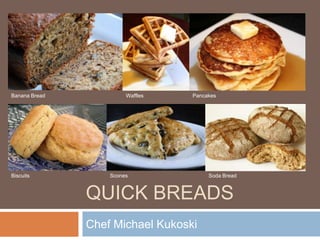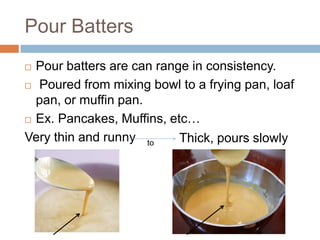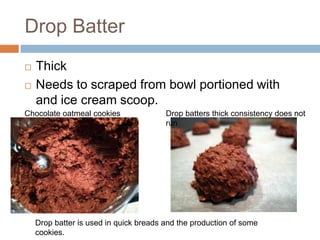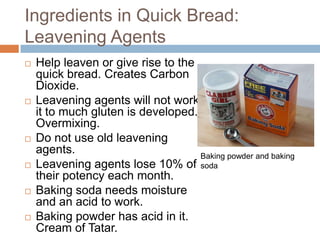Quick Breads
- 1. Quick breads Chef Michael KukoskiBanana BreadWafflesPancakesBiscuitsSconesSoda Bread
- 2. LectureBackground InformationTypes of quick breads before baking (Batters and Doughs)Ingredients and their FunctionsMixing MethodsStep by Step Muffin ProductionQ nĪ» A
- 3. DefinitionQuick Breads- A type of bread made from quick-acting leavening agents, such as baking powder. Besides the main ingredients spices, nuts, and fruit are added to alter flavors.Quick breads can beĪŁ Savory or sweet.Served warm or cold.
- 4. History/Background of Quick BreadsAbout 150 years agoĪŁQuick compared to yeast (traditional) Ammonium CarbonatePearlash (Potash) Baking SodaHave bread/cake textureTender Easy to produce and can be made quickly Bread risesCO2
- 5. TypesThree types of quick breads that produce different textures in the end product.Rolled out biscuit doughPancake batter poured out of dispenserMuffin drop batter
- 6. Soft DoughsThick consistencyRolled outMix Ingredients only until they are blended. STOP!DO NOT DO NOT overmixSoda Bread doughBiscuit doughScone doughWhen properly mixed, soft doughs are just combined and the dry ingredeints are just moistened. Stop before it looks like a solid brick of dense dough.
- 7. Pour BattersPour batters are can range in consistency. Poured from mixing bowl to a frying pan, loaf pan, or muffin pan.Ex. Pancakes, Muffins, etcĪŁVery thin and runnyThick, pours slowlyto
- 8. Drop BatterThickNeeds to scraped from bowl portioned with and ice cream scoop.Chocolate oatmeal cookiesDrop batters thick consistency does not runDrop batter is used in quick breads and the production of some cookies.
- 9. Ingredients In Quick BreadsFlour-hard and soft wheat floursEggs-large whole eggsFat- usually shortening or oilSugar- granulated (confectioners)Salt- Morton's iodized saltLeavening Agents- Double acting baking powder baking sodaLiquid- Milk
- 10. Ingredients in Quick Bread: FlourProvides structure and a foundation.A combination of hard and soft wheat flours is best.Can provide flavor and textureOther Grains used: Bran, Corn meal, oatmealSoft (cake) flourAll PurposeHard (bread) flour+=
- 11. Ingredients in Quick Bread: EggsAdds volumeAdds structure.Provides natural leavening.Besides texture eggs add Color, Richness, and flavorFarm fresh large brown whole eggs
- 12. Ingredients in Quick Bread: FatKeeps product moist and tender.It adds in creaming or mixingAll Purpose ShorteningVegetable Oil
- 13. Ingredients in Quick Bread: SugarMost of the formulas call for Granulated.Other sugars include molasses and brown sugar.Different sugars add sweetness, improve flavor, and adds to color.Aids in creaming.Granulated sugarBrown SugarMolasses
- 14. Ingredients in Quick Bread: SaltStrengthens glutenCreated by mixing flour and a liquidAdds flavor
- 15. Ingredients in Quick Bread: LiquidUsually milkAdds MoistureAllows dry ingredients to dissolve into liquid. Creating a well blended batter or dough.Helps create gluten when mixed with flour.
- 16. Ingredients in Quick Bread: Leavening AgentsHelp leaven or give rise to the quick bread. Creates Carbon Dioxide.Leavening agents will not work it to much gluten is developed. Overmixing.Do not use old leavening agents.Leavening agents lose 10% of their potency each month.Baking soda needs moisture and an acid to work.Baking powder has acid in it. Cream of Tatar.Baking powder and baking soda
- 17. Mixing Quick BreadsMixing time effects texture. Very Important! Normal OvermixedUndermixingLumpy batter Dry Pockets of flourOvermixingApple upside down cakeOverdevelops glutenMakes batter stringy and elasticEnd product is toughEnd product has large irregular holesTunneling occurs when overmixingTunnelsTough crumb
- 18. Mixing Methods (1 of 3): BiscuitCut fat into dry ingredients.Then add liquid ingredients.Knead until dry ingredients are absorbed.When mixed just enough end product is flaky.Overmixed= slate biscuitsFat and dry resemble cornmealProper kneading= Flaky
- 19. Mixing Methods (2 of 3): BlendingCombine all the liquid, sugar, liquid fat, and eggs at once.Add dry.Blending until the dry ingredients are moistUsed in Muffins, loaf breads, fruit bread, pancakes, and waffles.Combined liquid, sugar, liguid fat, and eggs. Now adding dry ingredients.
- 20. Mixing Methods (3 of 3): CreamingUsing a paddle on low speed cream together pre-softened shortening and sugar. Light and fluffy.Add eggs on at a time.Alternate adding dry and liquid ingredients.Makes a cake-like texture.Creaming fat and sugarAdd eggsAlternate dry and liquid
- 21. Muffins OverviewMuffins are served at breakfast lunch and sometimes dinner.Quality muffins are uniform in shape and size. Maintain an even crumb. Golden crust.Flavor is altered with the addition fruits or nuts. Muffin should be sweet with no after taste
- 22. Production: Scale/ Mixing MuffinsM.E.P./ Scale Mixing methods used in muffin production are either blending or creaming.Mixing method determines texture.Blending method= allows batter to be interchangeable.Creaming method= makes a cake-like texture.
- 23. Production: Dividing MuffinsFrom mixing bowl to muffin panScrape downward from outer edge. Prevents overmixing.Make sure portions are even.Greased muffin pans half full.The use of paper cups provides a moist, tender exterior. Crust forms without them.Lemon poppy seed muffins being divvied with potion scooperMuffin pan filled ? way with out paper liners
- 24. Production: Baking MuffinsMuffin batter can be refrigerated for 3 days. Frozen for 2 weeks in pan. Batter will lose volume as time goes on.Muffins are typically baked at 385 degrees Fahrenheit to 400 degrees Fahrenheit.Before baking muffins can be topped withĪŁBake muffins for proper time. To test for doneness by pressing muffin, it should spring back. Golden brown.Streussel Nuts Sugar
- 25. Production: Cooling & ServingLet muffin pans cool on wire rack until muffins are warm.Invert pan so warm muffins come out. Tap.Serve muffins the day of baking. Cooling on wire rackServed with Jam
- 26. What To Look For In a Quality MuffinAppearanceUniform, round, dome topColorGolden brownTextureEven crumb, tender, moist, NO tunnelsFlavorSweet, no bitter after taste
- 27. Production: Beware!Common MistakesMixing time is essential to achieving the proper texture in quick breads.Doughs made with the biscuit method do not to rise when the dough is over worked or it is rolled out to many times.Undermixing= pockets of dry ingredients.Cream butter and sugar into a consistent light,fluffy mixture.Uniform dividing
- 28. ReviewQuick Breads- A type of bread made from quick-acting leavening agents, such as baking powder.Three types of quick breads that produce different textures in the end product.Ingredients: Flour=Structure Eggs=volume + structure Fat=tenderizer Sugar=flavor + color (creaming) Salt= flavor + strength (gluten) Leavening agents= rise Liquid= moisture (gluten)Drop and Pour batters, soft doughsThree Mixing methodsMuffin ProductionQuality Muffins
- 29. Questions, Concerns, or ConundrumAny questions before we produce our own quick breads?




























